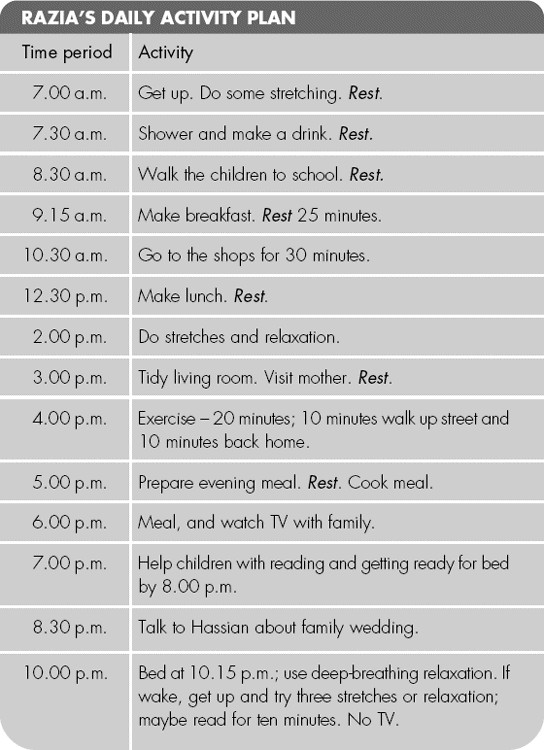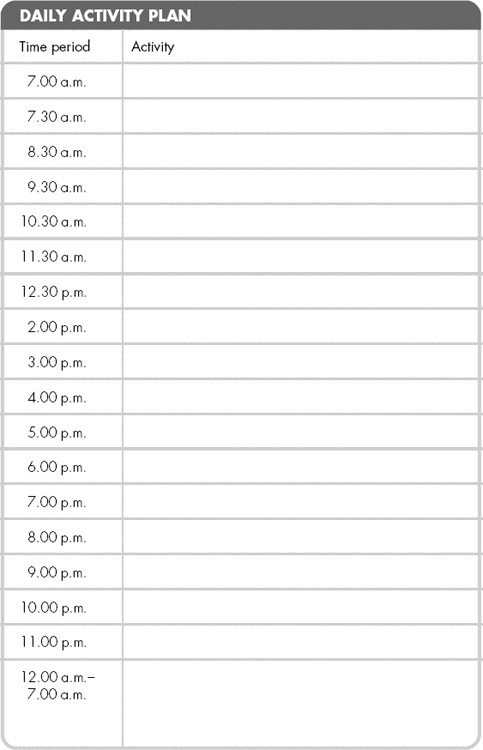
- •Other titles in the series include:
- •Overcoming chronic pain a self-help manual using Cognitive Behavioral Techniques frances cole, helen macdonald, catherine carus and hazel howden-leach
- •Isbn: 978-1-84119-970-2 eIsbn: 978-1-47210-573-8
- •Table of contents
- •Acknowledgements
- •Foreword
- •Introduction by Peter Cooper Why cognitive behavioral?
- •Introduction
- •Who might benefit from using this book?
- •What does chronic pain mean?
- •What is Cognitive Behavioral Therapy?
- •How can a book help?
- •How can I get the most out of using this book?
- •What do the chapters cover?
- •How do I start using this book?
- •Four case histories
- •Using the person-centred model
- •Maria and the person-centred model
- •How did the model help Maria make changes for the better?
- •How can the person-centred model help you get ready tomake some changes?
- •Getting started
- •Reducing the impact of pain on your daily life
- •How do you or others see these changes occurring?
- •Understanding chronic pain and pain systems
- •Understanding pain
- •Acute and chronic pain
- •What is acute pain?
- •What is chronic pain?
- •Acute and chronic pain systems
- •The acute pain system
- •The chronic pain system
- •Theories of pain The Gate Control Theory of Pain
- •Other theories of pain
- •Frequently asked questions
- •Understanding investigations for pain
- •Blood tests
- •Waiting for tests and results
- •Understanding the roles of healthcare professionals
- •Healthcare professionals
- •What is the role of a physiotherapist?
- •How do physiotherapists work?
- •What is the role of a specialist pain nurse?
- •What is the role of a pain specialist?
- •What is the role of a psychologist?
- •What is the role of a psychiatrist?
- •Talking therapies
- •Cognitive Behavioral Therapy
- •Pain management programmes
- •Understanding medicines and using them better
- •What types of medicines are used to manage chronic pain?
- •How are medicines used? Analgesics
- •Problems with medicines
- •Making better use of medicines
- •Four suggestions for using medications more helpfully
- •Stopping or reducing your medicines
- •Part two Overcoming Chronic Pain
- •Introduction
- •Setting goals
- •What are goals?
- •Informal and formal goals
- •What are smart goals?
- •Setting goals
- •Using a goal ladder
- •Achieving your goals
- •Giving yourself rewards
- •What are rewards?
- •Creating a ‘fun presciption’
- •50 Mg of fun three times a day (at least) For maximum benefit, use imagination!
- •Understanding pacing skills
- •What is pacing?
- •What are the different styles of pacing?
- •What type of pacing style do you use at present?
- •If pain levels are low, do you:
- •If pain levels are high, do you:
- •How to change your pacing style
- •Experimenting
- •Planning
- •Priorities
- •How to deal with barriers to realistic pacing
- •Getting fitter and being more active
- •How being more active can help you manage your pain
- •Trying to get fitter: What does having more pain mean?
- •Why do these types of activity cause aches and pains?
- •Assessing your present activity level
- •Frequently asked questions about increasing physical activity
- •How to get started on a basic exercise programme
- •Strength exercises – do slowly
- •Stretches for flexibility
- •Understanding problem-solving
- •What is problem-solving?
- •The main steps in problem-solving
- •Putting the problem-solving process into practise
- •Problem-solving guide
- •Understanding sleep and sleep problems
- •What sort of sleeping problems can be caused by chronic pain?
- •What kind of sleep pattern do you have at present?
- •How much sleep do you need?
- •How to use a sleep diary
- •How can you change unhelpful sleep habits?
- •Relaxation
- •What is relaxation?
- •How can relaxation help with chronic pain?
- •What can help you relax?
- •How to practise relaxing
- •Time out relaxation
- •What can make it difficult to practise relaxation?
- •Pain, communication and relationships
- •Part 1: communication and sharing concerns How close relationships can be affected by pain
- •How to manage difficulties in relationships
- •How to change behavior
- •How to communicate and share your concerns
- •Part 2: chronic pain and sexual relationships
- •How to deal with sexual problems
- •How to make sexual relationships easier
- •Managing depression, anxiety and anger
- •What moods can occur because of pain?
- •Part 1: managing depression
- •Why do people become depressed with chronic pain?
- •How depression affects people’s thinking
- •What factors can contribute to depression?
- •Unhelpful thinking in depression
- •Using anti-depressants
- •Part 2: managing anxiety
- •What is anxiety?
- •What are the effects of anxiety?
- •How does anxiety affect the body?
- •Anxiety and chronic pain
- •Managing anxiety by dealing with unhelpful thinking
- •Overcoming avoidance
- •Changing unhelpful behaviors
- •Part 3: managing anger
- •How anger affects you and your pain
- •How chronic pain and anger are linked
- •How being angry can affect other people
- •How to manage anger better
- •A coping plan
- •Acceptance
- •What is acceptance?
- •How can acceptance help you manage chronic pain?
- •What is attentional control or mindfulness?
- •1. Reasonable (thinking reasonably)
- •2. Emotional (thinking emotionally)
- •3. Wise (being mindful)
- •Mindfulness skills
- •1. Observing
- •2. Being ‘non-judgemental’
- •3. Focusing on one thing now and being in the present
- •4. Doing what works
- •Mindfulness exercises
- •Maintaining progress and managing setbacks
- •How can you maintain progress?
- •Obstacles to progress
- •What is a setback?
- •How can you manage a setback?
- •Looking to the future and managing work
- •How are new ways of life and new roles possible?
- •How can you use a positive data log?
- •Thinking through work, training and other options
- •How can you stay at work or return to work successfully?
- •Useful information
- •Professional organizations
- •Self-help groups and organizations
- •Books and publications
- •Self-help books
- •Tapes and cDs
- •Useful videos
- •Wordlist
Priorities
Choose the most important things to work on first. You might include:
• Leisure activities and hobbies, e.g. swimming, walking, planting in the garden, making cards.
• Social activities, e.g. going to see a film at the cinema.
• Household tasks, e.g. ironing clothes.
• Self-care, e.g. styling your hair, cooking a healthy meal.
• Work (paid or voluntary), e.g. in a local charity shop.
There are different ways to change your pacing style. Here are some suggestions.
STEP ONE
List each activity and record the time it took you on a recent good day and a recent bad day (see Razia’s Pacing Plan below).
STEP TWO
Under the ‘Everyday plan’ heading, write the number of minutes in which you could realistically carry out that activity every day, despite pain.
STEP THREE
Under the ‘Times per day’ heading, write down the number of times you could repeat the activity. It may help to break tasks down into smaller activities: e.g. ironing for 10-minute periods; or painting a wall, then having a rest break (see Razia’s Daily Activity Plan below).
Here is Razia’s Pacing Plan, as an example:

This means that Razia plans to stand and cook for 12 minutes, six times per day. After each 12-minute cooking session, she will take a 5-minute break to sit down. Then, Razia could walk around and do three specific stretches for 4 minutes. See chapter 9. She could then return to standing to cook or move on to another activity.
Razia then gradually increases the everyday plan time by 2 or 3 minutes every four or five days. For example, after a month she has increased in her everyday plan her standing activities, like cooking, to 22 minutes. She rewards herself with her favourite fruit in season, mangoes. She starts thinking about other things she could do with the children.
Now try filling in your own Pacing Plan on the opposite page.
Pacing means thinking about:
• How often to do an activity.
• How long to spend sensibly at an activity.
• When to do it in a typical day.
It sometimes means reducing unhelpful activities and increasing others. For example, Razia realized her underactive pacing style meant she needed to reduce her long periods of rest in bed. She still had breaks but planned fewer and shorter rest times (see her Pacing Plan above). This helped her fitness increase steadily.

Razia’s Daily Activity Plan (see overleaf) shows how she planned parts of her days, putting in her priorities, like taking the children to school. Her plan helped her pace. At the end of the day she could see she was more active (especially with the children), getting fitter and still had some rest times. She shared her plan with Hassian, her husband, and he was very supportive and offered some ideas too.

Here is a Daily Activity Plan for your own use. There is a spare Daily Activity Plan sheet, if you need it, at the back of the book (see p. 295).

How to deal with barriers to realistic pacing
Start by trying to work out what sort of situations might stop you from pacing more effectively. For instance:
• Having to meet a deadline at work
• Being ill, e.g. having flu
• Having to cope with family demands
• Having to deal with an emergency
• Having a good or bad pain day
In your notebook, write down any barriers that you are facing at the moment.
Then, next to each barrier, write down what you can do to tackle it (see Chapters 6, 7, 9, 10 and 16 for ideas).
Here are some tips for success in changing your pacing style:
• Time yourself while doing each activity.
• Don’t say ‘I’ll just do 5 more minutes’ or ‘I’ll just finish this bit’. This type of thinking leads to overactive pacing.
• Try and do some activity on bad days, even if it’s only 5 minutes. Be aware of unhelpful negative thinking or fearful predictions on difficult pain days. This type of thinking can reduce your activity further, so experiment.
• Steadily increase the level of your activity. For example, you could gradually lengthen the time you spend driving the car from 10 minutes to 20 minutes over a three-week period.
• Record and reward your achievements.
CHAPTER SUMMARY
• Pacing is an important skill that can improve all aspects of your life. Identifying your pacing style and making changes helps you balance activities and breaks.
• If you are underactive, you need to steadily pace yourself towards a more active life. If you are overactive, you need to plan more rest times and relaxation.
• If you have a mixed pacing style, you need to monitor your activity. Get to know the situations, times or thinking that trigger a period of overactivity or underactivity.
• Plan each day and choose what is important to achieve. Priorities are a vital part of pacing skills. Experiment with your Daily Activity Plan, especially with finding a balance between activities and rest or relaxation breaks. Reward yourself often, especially for effort.
9
